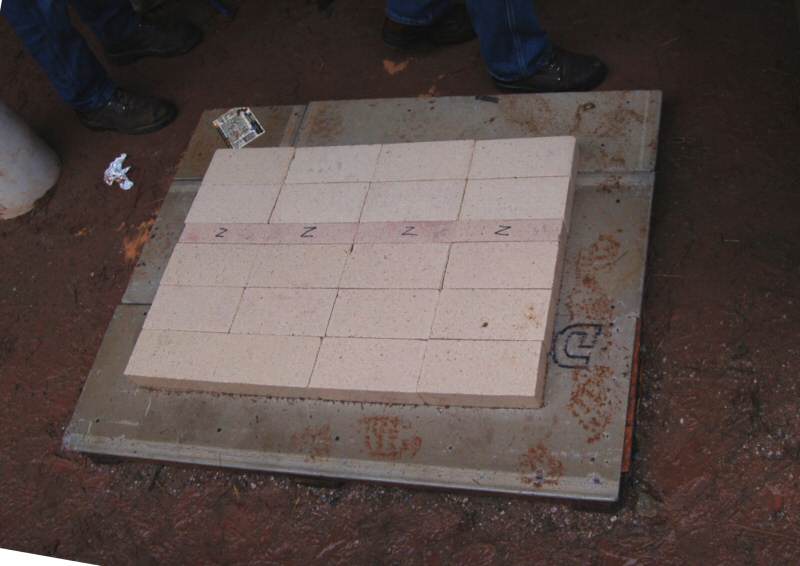
| Gallery | The Mall | Member Directory | MHA News | Library | Links |
This heater is similar to the soapstone 5 run heaters from the previous 3 years.
This year, it is a contraflow, which exits at the bottom, rather than at the top.
The bakeoven design is updated for more even floor heat.
A soapstone downdraft channel is used on the left side, and a firebrick downdraft channel
is on the right side, for comparison.

Chimney connection is visible at the bottom.
Firebox floor.
Bolted soapstone lintel for the firebox.
Corbelling underneath oven floor.
Instead of a bolted soapstone floor for the rear of the oven, a piece of Skamolex board is exposed to the fire.
Last year, under heavy overfiring, the bolted soapstone had some deterioration. Also, the oven floor was too
hot at the back.
Approx 3" of soapstone plates are added to the oven floor, in 2 layers.
The oven sides are soapstone bricks, same as in previous years.
View of the chamber above the oven.
Soapstone heat exchanger plates, held in place by the facing and solid mortar slush.
Notice the ceramic fiber expansion joint behing the plate. There is also expansion
at the ends of the plate.
For the previous heaters, a cardboard wrap was used around the entire core.
For this heater, there is no cardboard.
The firebrick heat exchanger side.
A soapstone frame will act as the mounting for the firebox door.
Drilling holes in the soapstone for anchor pins to the brick facing.
Installing the bake oven surround.
Lighting the fire.
There was no curing fire. We burned about 125 lbs of slightly wet locust hardwood.
A clean start.
The facing is starting to dry out.
Angled bricks at the back of the firebox.
More drying.
An expansion crack developed in the facing, identical on both sides.
This is an unusual location for an expansion crack in a contraflow heater.
During disassembly, we will try to analyze what caused this crack,
other than "lack of cardboard".
Charles Bozzo uses lime mortar to repoint the crack, while the heater is hot.
First, he racked out the clay mortar, then applied the lime in layers, using a brush
to dash on water to keep it from drying out.
Pizza time!
Pizza came out very well, with a nice looking bottom to the crust.
Almost dry.
Detail of the repair. The heater cooled overnight, and the crack did not reappear on the next day's heating cycle.
Disassembly and analysis.
A mortar bridge between the firebrick splits and the adjacent firebricks on the ends could
could cause a crack. However, except for the chunk of mortar visible next to the lower "BB",
the expansion joints were clean, with not contact.
Clear on the other side, although there is contact at one point.
The soapstone side had clear expansion joints.
View of the ceiling.
Firebrick side.
Soapstone side.
Bake oven floor.
There is solid contact at this point, where it could easily have an expansion joint.
It is not in the direct flame path from the firebox, however.
There could be an expanion joint added between the firebrick and the oven.
Skamolex. It was fine.
An expansion joint was specified at this location in the drawings, and is missing.
This region at the throat gets heated very rapidly.
This is a very likely cause for the unusual facing cracks.
Temperature data for the facing. There was a thermocouple in the flue, at the bottom of the run.
The flue temperature and outside temperature are shown for both sides.
The soapstone gas temperature was slightly cooler, indicating more heat transfer out of the gas,
The exterior temperatures on the soapstone side are about 20 degrees higher.
Temperature data for the bake oven.
The floor is a little cool at the front.
Normally there are two bypass slots under the front floor, to bypass some hot gas into the channels, and thereby
add heat to the front. The bypasses were not used on this heater, and will be installed when the heater gets
re-installed by the person who won it at the auction.
Thanks to Doug Hargrave for doing the soapstone fabrication, and donating the heater to the auction.
See also,
2007 Photo Report
2006 Photo Report
2004 Photo Report
2003 Photo Report
2002 Photo Report
2001 Photo Report
2000 Photo Report
1999 Photo Report
1998 Photo Report
1997 Photo Report
This page was last updated on May 1, 2012
This page was created on April 27, 2012